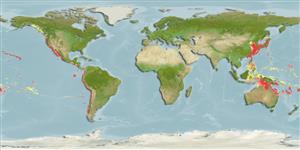Classification / Names
Common names from other countries
Main reference
Size / Weight / Age
Max length : 64.0 cm TL male/unsexed; (Ref. 9015); common length : 30.0 cm FL male/unsexed; (Ref. 168); max. published weight: 2.9 kg (Ref. 26550); max. reported age: 18 years (Ref. 35185)
Length at first maturity
Lm 26.1 range ? - ? cm
Environment
Marine; pelagic-neritic; oceanodromous (Ref. 51243); depth range 0 - 300 m (Ref. 168), usually 50 - 200 m (Ref. 35185)
Climate / Range
Subtropical; 10°C - 27°C (Ref. 35185), preferred 25°C (Ref. 107945); 60°N - 48°S, 116°E - 70°W
Distribution
Indo-Pacific: anti-tropical, absent from the Indian Ocean except for South Africa, KZN to Western Cape (58304).
Reports from Atlantic incl. Mediterranean are Scomber colias, and from Red Sea and northern Indian Ocean are Scomber australasicus (Ref. 27328).
Countries | FAO areas | Ecosystems | Occurrences | Introductions
Short description
Dorsal
spines
(total): 9 - 11;
Dorsal
soft rays
(total): 112;
Anal
spines: 1;
Anal
soft rays: 12 - 14;
Vertebrae: 31. Interpelvic process small and single. No well developed corselet. Swim bladder present. First haemal spine posterior to first interneural process; 12 to 15 interneural bones under first dorsal fin. Anal fin spine conspicuous, clearly separated from anal rays but joined to them by a membrane. Back with narrow stripes which zigzag and undulate. Belly unmarked (Pacific population) or with wavy lines (Atlantic pop.) (Ref. 168). Caudal peduncle with 5 finlets on the upper and lower edge. Distance between dorsal fins shorter than or equal to the first dorsal fin base (Ref. 35388).
IUCN Red List Status (Ref. 115185)
Threat to humans
Harmless
Human uses
Fisheries: highly commercial; aquaculture: commercial; gamefish: yes; bait: usually
Tools
Special reports
Download XML
Internet sources
Estimates of some properties based on models
Phylogenetic diversity index
PD50 = 0.5625 many relatives (e.g. carps) 0.5 - 2.0 few relatives (e.g. lungfishes)
Trophic Level
3.4 ±0.1 se; Based on diet studies.
Resilience
Medium, minimum population doubling time 1.4 - 4.4 years (K=0.12-0.22; tm=2-3; tmax=18)
Vulnerability
Low to moderate vulnerability (31 of 100)
Price category
